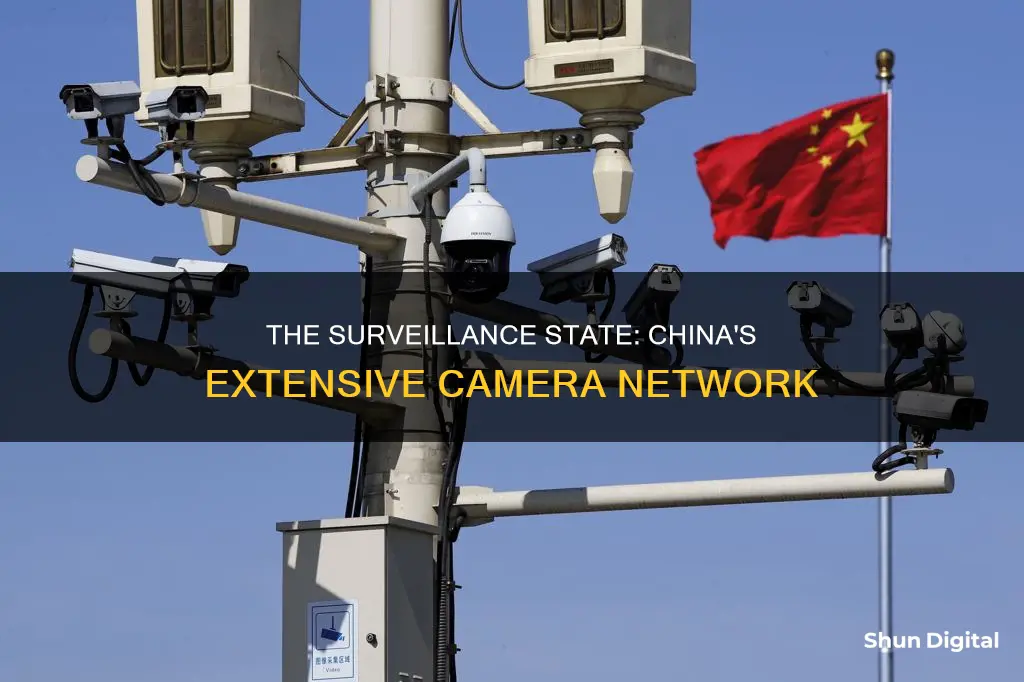
China has one of the most extensive surveillance systems in the world, with an estimated 540 million to 700 million CCTV cameras across the country. This means there is approximately one camera for every two citizens, or 373 cameras per 1000 people. The Chinese government claims that this extensive network, named Skynet, is necessary to prevent crime and maintain social order. However, human rights groups and citizens worry about the invasion of privacy and the potential for misuse of data. The surveillance system has been linked to the suppression of dissent and the targeting of specific ethnic and social groups, such as Uyghurs in Xinjiang and feminists and LGBT rights groups.
| Characteristics | Values |
|---|---|
| Number of surveillance cameras | Over 700 million |
| Surveillance cameras per citizen | 1 camera for every 2 citizens |
| Surveillance cameras in 2021 | 567 million |
| Surveillance cameras in 2019 | 200 million |
| Surveillance cameras in 2018 | 200 million |
| Surveillance cameras in 2017 | 626 million |
| Surveillance cameras in 2015 | 20 million |
What You'll Learn
- Cameras in China can identify people through facial recognition or gait recognition
- There are around 700 million surveillance cameras in China
- China has a camera for every 2 citizens
- Surveillance in China has expanded since the Covid-19 pandemic
- China's surveillance technology includes facial recognition, gait recognition, body scanning, and geo-tracking

Cameras in China can identify people through facial recognition or gait recognition
China has one of the most extensive surveillance systems in the world, with over 700 million cameras, or one lens for every two citizens. This vast network of cameras is capable of identifying almost every citizen through facial recognition technology. A database leak in 2019 exposed the extent of China's surveillance, revealing over 6.8 million records from a single day, including details of individuals as young as nine days old.
While facial recognition is the primary method of identification, China has also developed and deployed "gait recognition" technology. This system uses body movement, shape, and gait to identify individuals, even when their faces are hidden or turned away from cameras. Police in Beijing and Shanghai have been using this software, which can identify people from up to 50 meters away, to monitor individuals and fill the gaps where facial recognition may fall short.
Gait recognition software works by analyzing thousands of metrics about a person's walk, including body contour, arm movement, and gait type (toe-in or toe-out). This data is then stored in a database, creating a unique model of an individual's gait. The Chinese company Watrix, which developed this technology, claims that it can be used alongside facial recognition to enhance surveillance capabilities.
The widespread use of gait recognition in China has raised concerns about the potential for overreach and invasion of privacy. Critics worry that the technology will be used for social control and to enable a crackdown on minor offenses, as has been seen with facial recognition. Despite these concerns, China continues to lead the world in the development and deployment of advanced surveillance technologies.
Charging Polaroid Snap Cameras: A Quick Guide
You may want to see also

There are around 700 million surveillance cameras in China
China has been dubbed the world's most heavily surveilled state. With a population of over 1.45 billion, the country has an estimated 700 million surveillance cameras, meaning there is approximately one lens for every two citizens.
The surveillance camera system in China has expanded dramatically since the Covid-19 pandemic. In 2021, there were more than 567 million surveillance cameras in the country. This number increased to around 600 million in 2023, with some sources placing the figure at 626 million.
The Chinese government states that the cameras are being installed as part of their "digital health code". The cameras are used to monitor citizens' adherence to Covid-19 rules, such as wearing face masks, and to check if people are crossing the road before the green light for pedestrians is turned on.
The surveillance system in China is not limited to cameras. The government also employs facial recognition technology, surveillance drones, robot police, and big data collection targeting online social media platforms to monitor its citizens.
The extensive surveillance network in China has raised concerns about privacy and data protection. While the government claims that the system helps prevent crime, citizens worry about potential compromises to their data and privacy.
The heavy presence of surveillance cameras in China has led to a sense of constant camera surveillance, with citizens being watched at work, on the streets, on public transportation, and even inside their homes.
Traffic Camera Tickets: Enforceable in Florida?
You may want to see also

China has a camera for every 2 citizens
The country's camera surveillance system has expanded dramatically since the Covid-19 pandemic. In 2021, there were more than 567 million surveillance cameras in China. By 2023, that number had grown to 700 million.
The Chinese government says that many of these cameras are being installed as part of their “digital health code”. People are now being watched at work, on the streets, on public transportation, when they leave their homes and when they return.
China's surveillance cameras use facial recognition and "gait recognition" to identify individuals. "Gait recognition" software uses people's body shapes and how they walk to identify them, even when their faces are hidden.
The heavy presence of surveillance cameras in China has raised concerns about privacy and data protection. Critics argue that the government is using the cameras to target dissidents and crack down on any potential unrest.
The widespread use of surveillance cameras in China is part of the country's broader mass surveillance system, which also includes internet surveillance and other digital technologies.
The Polaroid SX-70 Land Camera: A 70s Innovation
You may want to see also

Surveillance in China has expanded since the Covid-19 pandemic
China's surveillance network has expanded significantly since the Covid-19 pandemic, with the country now boasting over 700 million surveillance cameras – one for every two citizens. This vast network of cameras is used to monitor Chinese citizens through internet surveillance, camera surveillance, and other digital technologies.
The Chinese government has justified the expansion of its surveillance program as a necessary measure to prevent crime and ensure public security. However, many citizens are concerned about the potential compromise of their data and privacy. The use of facial recognition technology and "gait recognition" software, which can identify individuals even when their faces are covered, has raised particular alarm.
The Covid-19 pandemic provided a plausible pretext for the Chinese government to accelerate the implementation of mass surveillance. The strict public health measures and lockdowns imposed during the pandemic severely impacted economic activities, especially for small and micro enterprises. The costs of continuing these stringent policies were enormous.
The pandemic also contributed to a decline in foreign investment and a rise in unemployment, particularly among young workers. The negative impact of the pandemic on the economy and society has likely played a role in the government's decision to expand surveillance measures.
The surveillance cameras in China are not just watching people's movements but also checking if they are following the rules. For example, the cameras check if people are wearing face masks and if they are crossing the road before the green light for pedestrians is turned on. If caught breaking these rules, people can face various consequences such as losing social credit points, being charged higher mortgage rates, and having to pay more for public transportation.
The expansion of surveillance in China since the Covid-19 pandemic has raised concerns about the government's intrusion into the lives of its citizens and the potential for misuse of the extensive data being collected.
Restarting Li-ion Camera Battery: Quick Guide
You may want to see also

China's surveillance technology includes facial recognition, gait recognition, body scanning, and geo-tracking
China has been at the forefront of mass surveillance, with over 700 million surveillance cameras as of August 2023, which amounts to one lens for every two citizens. The country's surveillance technology includes facial recognition, gait recognition, body scanning, and geo-tracking.
Facial recognition technology has been widely adopted in China, allowing authorities to identify individuals from large databases. This technology has been integrated with big data and AI, creating a national surveillance and data-sharing platform. For instance, smart systems equipped with facial recognition technology can identify jaywalkers and issue fines.
In addition to facial recognition, China has also developed gait recognition software that identifies people by their body shape and walking pattern, even when their faces are hidden. This technology is already being used by police in Beijing and Shanghai and has raised concerns about its potential for invasive surveillance.
Body scanning technology in China has advanced to the point where scanners can see through multiple layers of clothing. A body scanner developed using space radar technology has been tested and can produce clear images through clothes, potentially identifying forbidden items at security checkpoints.
Furthermore, China has launched advanced surveillance satellites, such as the Yaogan-41, which can provide continuous surveillance of the Pacific and Indian Oceans, as well as Taiwan and mainland China. This satellite, paired with others in its network, gives China an unprecedented ability to track objects and individuals in the region.
Focusing Your LG K20 V Camera: Tips and Tricks
You may want to see also
Frequently asked questions
As of August 2023, there were over 700 million surveillance cameras in China.
China has more surveillance cameras than any other country. By the end of 2021, it was estimated that China had 54% of the world's surveillance cameras.
The use of surveillance cameras in China has raised concerns about privacy and data protection. Cameras are used to monitor citizens in public spaces, in their homes, and even in toilet cubicles. The government claims that the cameras help prevent crime, but critics argue that they are used to target dissidents and infringe on civil liberties.
The cameras use facial recognition technology and 'gait recognition', which can identify individuals through body movement and shape, even when their faces are obscured.
The pandemic has accelerated the implementation of mass surveillance in China, with cameras being used to enforce mask mandates and social distancing rules.







